Desk Alternatives: A Complete Guide to Modern Workspaces

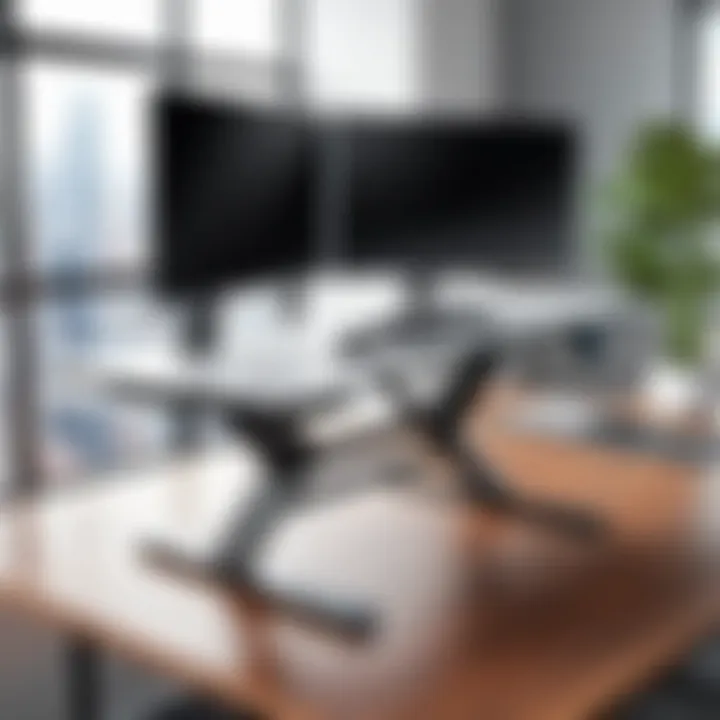
Intro
In our rapidly changing work environments, the traditional desk is no longer the sole option that accommodates our needs. With a surge in remote work and flexible hours, alternatives are becoming more mainstream. This shift calls for a deeper examination of what constitutes a conducive workspace. We're not just looking at physical structures, but also the psychological and ergonomic aspects that can make or break productivity. While some may cling to the familiar, others are stepping outside the box, exploring innovative workspace solutions that promote comfort and functionality.
The crux of this guide is not just to list out alternatives but to dissect each option's merits and drawbacks carefully. From standing desks that can help alleviate back pain to multifunctional furniture that adapts to various tasks, each choice brings its own set of considerations. Our aim is to provide readers with insights that can lead to informed decisions about their workspace setup.
Whether you're a software developer coding away at home, a professional in an IT-related field trying to maximize your efficiency, or a student seeking the perfect study nook, finding a workspace that complements your workflow is paramount. The following sections delve into different alternatives, providing a thorough understanding of their functionalities and suitability for various work scenarios.
Overview of Options
Purpose and Use Cases
To begin, let’s explore some common alternatives:
- Standing Desks: Designed to allow users to shift from seated to standing positions. They're beneficial for long hours at the computer, helping to enhance posture and reduce stagnation.
- Convertible Desks: These desks can transform from a sitting to a standing position, offering the best of both worlds. They cater to those who want flexibility without buying multiple pieces of furniture.
- Workbenches or Tables: Simple yet effective, they provide ample work surface and can be easily adjusted according to user preference.
- Multi-functional Furniture: This includes pieces like foldable desks or desks with built-in storage. Such designs are especially handy for small spaces or for those who like to keep things versatile.
Each of these options presents unique benefits. For instance, standing desks are often touted for their health advantages, while convertible desks offer versatility, catering to a dynamic workflow.
Key Features
When considering alternatives to the traditional desk, one should note key features that enhance usability:
- Adjustability: The ability to change height or configuration is crucial for comfort.
- Stability: A solid design ensures that the workspace remains functional even when handling equipment such as laptops or multiple monitors.
- Aesthetics: An attractive design can enhance the overall workspace vibe, providing motivation to engage in work.
- Storage Options: Integrated storage can help keep your workspace tidy and your materials at hand.
"It's not just about having a place to work; it's about creating an environment that's conducive to creativity and efficiency."
In-Depth Review
Performance Analysis
In examining the performance characteristics of these alternatives, standing desks often receive commendations for promoting physical activity. Studies indicate that standing while working can decrease risks associated with sedentary behavior. However, they are not without challenges; some users may find it tiring to stand for prolonged periods.
Convertible desks also make a strong impression. Their versatility means they can accommodate various tasks without missing a beat, whether you're seated for a focused coding session or standing for video calls. A crucial point, however, is the mechanism of adjustment—clunky or unreliable mechanisms can lead to frustration.
User Interface and Experience
User experience is another cornerstone to consider. For instance, multi-functional furniture often wins points for practicality, but the usability can hinge on how user-friendly the design is. Those with intuitive adjustments make for a smoother transition between tasks. Consider also the aesthetic impact: a cluttered interface, even in physical form, can deter concentration.
As we navigate through different alternatives, it's essential to align our choices with how we work best. Everyone has different habits and preferences, and understanding these aspects will lead to a more satisfying workspace.
Understanding the Need for Desk Alternatives
As the nature of work has shifted significantly over the years, particularly with the rise of remote work and flexible hours, the traditional desk setup is no longer a one-size-fits-all solution. The need for alternatives is a response to diverse work habits and lifestyles. Today’s work environments are not confined to four walls; they often span living rooms, coffee shops, and co-working spaces. A desk alternative can offer benefits that might align better with individual preferences or specific tasks, enhancing both comfort and productivity.
The Evolution of Workspaces
The workspace has undergone a remarkable transformation. Gone are the days when cubicles ruled the roost. Now, more fluid and dynamic arrangements have taken their place. Think about it: the shift from rigid office setups to open-plan designs signifies a broader change in how we perceive work. Consider how businesses have tried to squeeze more out of less space by encouraging collaboration and communication, often at the expense of traditional desks.
Moreover, technology plays a significant role in this evolution. With the advent of laptops, tablets, and smartphones, employees are not bound to a particular space. They can work from nearly anywhere.
Impact on Health and Well-being
Choosing the right workspace affects physical and mental health. Traditional desks may lead to prolonged periods of sitting, which can adversely affect posture and overall health. Back pain, fatigue, and even mental burnout are becoming common complaints. Studies indicate that moving away from the standard sit-down routine can improve well-being. By exploring alternatives like standing desks or convertible setups, individuals can mitigate some of these risks.
"Your workspace significantly impacts your health and productivity; finding the right solution can make all the difference."
Additionally, the flexibility to switch between different alternatives can lead to a more engaged and motivated worker. People often feel more energized and creative when they can adjust their workstations according to their comfort needs.
Shift Towards Flexibility and Mobility
The future of work is undeniably flexible. Individuals are demanding options that allow them to customize their work environments. Flexibility is not just about where you work; it's about how you work. For example, professionals in information technology often benefit from the ability to adapt their workspace throughout the day, whether it’s standing for a conference call or sitting down to review code.
This shift encourages productivity and innovation. As boundaries blur between personal and professional spaces, the way people approach tasks becomes more varied. Mobile workstations, such as wheeled desks or setups that can be easily disassembled for travel, provide substantial benefits in dynamic work environments. In sum, flexibility is becoming indispensable for those looking to remain productive while maintaining a comfortable workspace.
Exploring Standing Desks
Standing desks have turned into a hot topic in workplace conversations. With the modern work environment shifting towards more ergonomic solutions, these desks are becoming more than just a trend. They're a response to various issues related to health, comfort, and productivity. Standing desks allow users to escape the traditional seated posture that can contribute to various health problems. They set the stage for a more dynamic working experience. However, it's essential to examine them through multiple lenses: types available, their benefits, and considerations to keep in mind when choosing the right option.
Types of Standing Desks
Manual vs. Electric Models
When it comes to standing desks, the choice between manual and electric models often weighs heavily on the user’s lifestyle and preferences. Manual desks typically involve a crank or lever that requires arm strength to adjust the height. This physical engagement can be appealing for those who enjoy a bit of movement throughout their workday. On the flip side, electric models provide convenience at the push of a button, making them a popular choice for busy professionals who may not wish to break their workflow just to adjust their desk height. While electric models are often seen as sophisticated tools, they may come with a higher price tag. However, the ease of use often justifies the investment, especially for those who anticipate frequently changing positions.
Fixed Height vs. Adjustable Height
When discussing fixed versus adjustable height desks, it's crucial to focus on the flexibility that an adjustable desk provides. Such desks allow users to set their workspace to their liking. Alternatively, fixed-height desks emphasize simplicity and reduced costs. They might be a good solution for someone who has a set routine and doesn’t foresee changes in their height preferences. Fixed desks, however, may not accommodate everyone's needs, especially when multiple users are sharing the same workspace. Each choice features trade-offs between usability and adaptability.
Benefits of Standing Desks
Enhanced Posture and Reduced Pain
One of the primary advantages of standing desks is their potential to improve posture. Many workers find themselves slouching when sitting, leading to neck and back pain. Standing desks encourage a more upright alignment, which may lessen these discomforts over time. This newfound awareness often promotes better habits for those who have long been rooted in sedentary work.
Increased Energy and Productivity
Research indicates that standing while working can increase energy levels, leading to improved productivity. A change in stance can send fresh blood flow to the brain, allowing for clearer thinking and better concentration. This can be particularly beneficial for software developers and IT professionals who rely on prolonged focus while they code or engage in complex problem-solving tasks. However, it's important to strike a balance; standing all day can be exhausting too. Interchanging positions throughout the day is the secret to harnessing this benefit without falling into fatigue.
Considerations When Choosing a Standing Desk

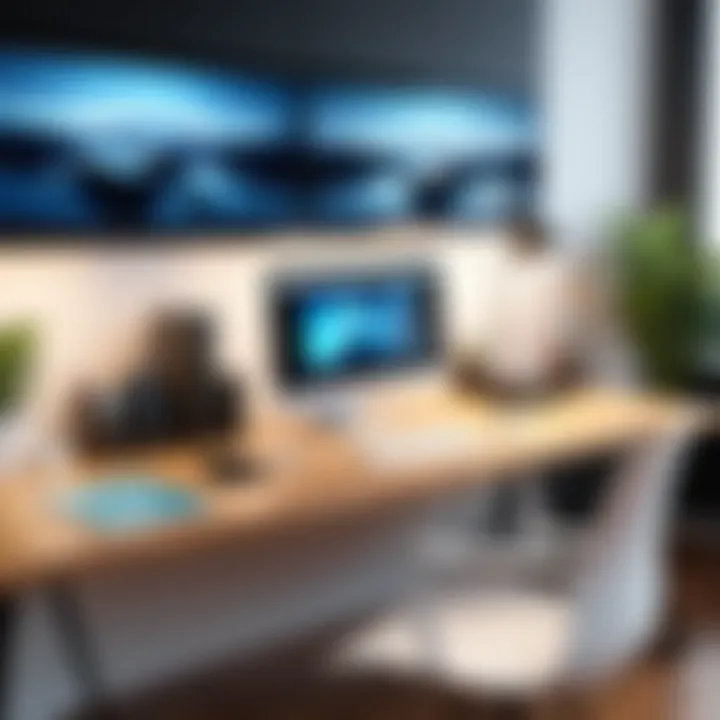
Space Constraints
Choosing a standing desk goes beyond merely picking a model that looks good. A critical factor is the available space. It's not just about having enough room; it’s also about how the desk interacts with other elements in the workspace. In smaller areas, users might find fewer options, leading them to prioritize compact and efficient designs. A desk that fits neatly without clutter can greatly enhance comfort and functionality.
Budgetary Limits
The costs associated with standing desks can vary widely. While some manual desks can be significantly cheaper, electric models often come at a premium. However, investing in a desk is just one part of the equation. Users should consider the potential long-term health benefits and increased productivity—it might just save on medical bills or boost overall career performance. In this context, aligning the choice of desk with one's budget without skipping on the desired features becomes essential.
It's clear that the transition from traditional seated workstations to standing and adjustable options represents a significant shift in workplace dynamics. Finding the right standing desk is about matching personal preferences and lifestyle needs with available options.
Utilizing Kneeling Desks
Kneeling desks are making a splash in conversations about modern work environments. Given the changes in how we approach work and productivity, understanding and utilizing kneeling desks can be a game-changer for many professionals. These desks offer a fresh perspective, particularly for individuals seeking a balance between comfort and health while working. In this section, we'll unlock the key elements related to kneeling desks, including their unique attributes, advantages, and potential drawbacks.
Understanding Kneeling Desks
So, what exactly is a kneeling desk? These desks are specially designed to shift your body into a more natural position while working. Instead of the typical seated position, they encourage you to kneel with a padded surface for your knees and a seat that supports your hips and enjoys better alignment of your spine. This design ultimately aims to promote ergonomic benefits despite its peculiar comfort level for first-time users. Transitioning to a kneeling desk can feel a bit like learning to ride a bike—awkward at first, but rewarding once you get the hang of it.
Advantages of Kneeling Desks
Reduced Lower Back Pressure
A standout feature of kneeling desks is their ability to reduce lower back pressure. When you kneel, your spine naturally aligns in a way that abates common complaints such as tension in your lower back. This is crucial for anyone spending long hours hunched over a computer screen. The hip-supported position encourages a more open hip angle, relieving stress on the lumbar region. As a result, it’s seen as a beneficial choice for those looking to enhance their work setup. The unique feature of a kneeling desk is how it shifts weight distribution across the knees and hips, which can lead to sustained periods of productivity without the typical discomfort that comes from prolonged sitting.
Encouragement of Proper Alignment
Another charming aspect of kneeling desks is their tendency to foster proper body alignment. This aspect isn’t merely incidental; it’s designed intentionally to keep your spine in a neutral position. The ergonomic seat supports your body in a way that encourages healthy posture, minimizing the chances of developing bad habits over time. For individuals already dealing with skeletal issues, this could be a popular option. The unique setup of a kneeling desk essentially urges you to sit up straight, ensuring that head and neck remain in line with your spine. This could lead to a notable improvement in overall comfort, energy levels, and even mood.
Potential Drawbacks of Kneeling Desks
Discomfort During Extended Use
Despite the appealing benefits, kneeling desks are not without their own set of challenges. A key drawback to keep in mind is the discomfort that may arise during extended use. Especially for newcomers, the initial thrill might wear off after long hours. Kneeling for a prolonged period can lead to muscle fatigue in the legs and discomfort in the knees. While the design aims to distribute weight better, individuals may find that kneeling for hours isn’t as straightforward as it seems. It becomes a juggling act between comfort and productivity.
Limited Workspace Area
On top of that, kneeling desks often feature a limited workspace area. With a smaller surface size compared to traditional desks, they can bring about challenges for those requiring ample space for documents, electronic devices, and other materials. Professionals in creative fields, who often juggle multiple projects, might see this confinement as a hindrance. Despite their ergonomic design, a lack of space means you could potentially compromise on organization.
Navigating the options of kneeling desks may require careful consideration. While they offer distinct benefits, they also bring potential discomfort and spatial limitations. As with many aspects of workspace alternatives, finding the right fit directly relates to individual needs and preferences. In a world where comfort and productivity go hand in hand, kneeling desks have carved out a unique niche worth exploring.
Exploring Convertible Desk Options
What are Convertible Desks?
Convertible desks are a type of furniture designed to adapt to different use cases, allowing individuals to switch between various positions or configurations throughout the day. These desks often offer the ability to change heights, shapes, or even extend to accommodate different working styles. Their inventiveness lies in catering to the diverse needs of people, whether they’re writing a document, engaging in a video call, or working on a coding project.
What sets convertible desks apart is their focus on versatility. Rather than being confined to the traditional sit-down format of a desk, they provide options that open up a whole new world of workstation layouts. This has made them increasingly popular in a world that values flexibility—especially as remote work becomes the norm.
Advantages of Versatile Workstations
Adaptability to Various Tasks
One major advantage of convertible desks is their adaptability to various tasks. This means users can easily switch from sitting for a long stretch to standing while discussing ideas over a video call. This ability to transition seamlessly fosters not just comfort, but also productivity. For professionals, such as software developers who may need to run through a demanding coding session, having the flexibility to switch positions can dramatically reduce fatigue and improve overall performance.
The unique feature of this adaptability is that it encourages users to maintain an engaged stance, rather than being locked into one position for hours. It's a key characteristic that has proven beneficial for many. Users may find that they become more innovative when they can move around and adjust their workspace to fit the project at hand.
Encouragement of Movement and Flexibility
Furthermore, convertible desks come with the encouragement of movement and flexibility. This specific characteristic is particularly relevant as more studies highlight the importance of movement in everyday tasks. When users can easily adjust their workstation, it prompts them to change position, which can break the monotony and help maintain vigor throughout the day.
The unique aspect of this encouragement is that it provides instant adaptability. For instance, during a lengthy brainstorming session, switching from a sitting to a standing position can reinvigorate the flow of ideas. However, it's essential to balance movement with the right level of support to prevent discomfort that can arise from prolonged standing.
Accessibility and Usage Considerations
Ease of Adjustment
When discussing convertible desks, ease of adjustment is crucial. This allows users to customize their desk height or position without the hassle of extensive setup. Desks that can be adjusted with minimal effort significantly enhance the user experience.
The standout feature of ease of adjustment is that it can often be achieved with a simple lever or electronic controls. This capacity to quickly change height or configuration plays a vital role in creating an ergonomic workspace. Nevertheless, potential downsides can arise if adjustments seem complicated or if a desk struggles to hold position once set.
User Requirements
Lastly, understanding user requirements is essential when considering convertible desks. Each individual has different preferences based on their height, comfort levels, and work habits. Thus, these desks must cater to a broad audience to be viable.
The key characteristic here is customization, which can lead potential buyers to assess their specific needs before making a decision. Personalized adjustments can lead to better productivity, but the challenge remains in ensuring that the desk can accommodate varying requirements without compromising stability or performance.
"A desk that adjusts to students' or professionals' specific needs transforms their work practice, accommodating their rhythm in a unique manner."
In summary, convertible desks offer a wealth of advantages. They are not just about practicality, but about enhancing users’ daily experiences by providing them the tools to forge their unique working environments.
Incorporating Coffee Table Desks
In the quest for versatile workspace solutions, coffee table desks have emerged as unexpected but practical alternatives to traditional desks. These informal workspaces cater specifically to those who find the rigidity of a standard desk unappealing. The importance of this option lies in its ability to fuse comfort with functionality, encouraging creativity and casual work habits without sacrificing productivity.
Coffee Tables as Workspaces
Coffee tables serve a dual purpose that can be quite beneficial in modern environments—especially for those working from home or in informal settings. Instead of being mere decorative pieces, they transform into practical work platforms. This versatility offers a creative impulse for individuals who might thrive in more relaxed atmospheres. Moreover, using a coffee table can stimulate a different mindset, facilitating brainstorming or collaborative efforts in a laid-back context.
Pros of Using Coffee Tables

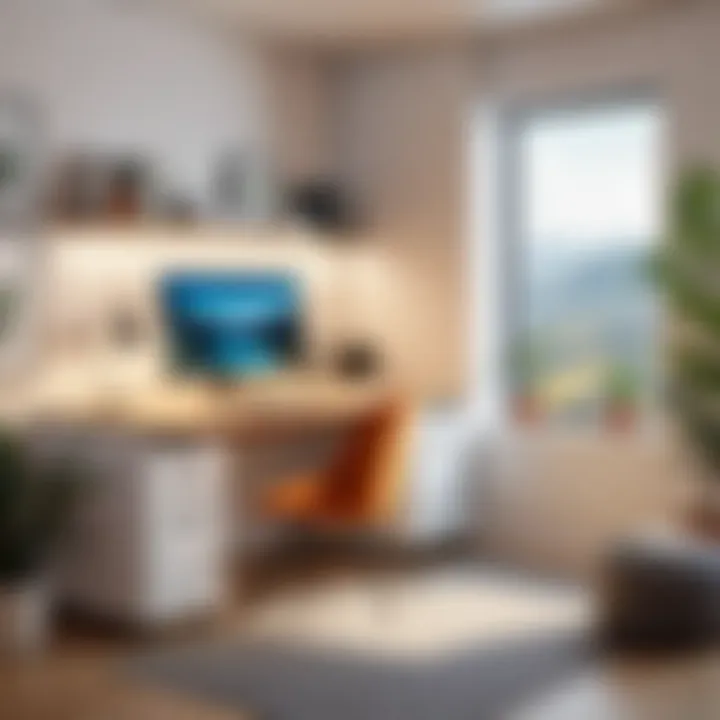
Space-Saving Solutions
One of the significant aspects of utilizing coffee tables as workspaces is their ability to save space without compromising functionality. In smaller rooms or apartments, these tables allow for a clutter-free environment, efficiently combining relaxation and productivity. The compact nature of coffee tables means they can fit snugly into tight areas and still serve multiple purposes—from serving drinks to hosting work sessions. It's a beneficial choice for those with limited square footage yet who want a functional workspace.
- Unique Feature: The versatility in size and shape of coffee tables means they can be adjusted against walls or used in various locations around the home.
- Advantages: They reduce the need for additional furniture and encourage a more simplified lifestyle.
Multi-Functional Furniture
Coffee tables exemplify the beauty of multi-functional furniture, combining usability with aesthetic appeal. Their design often includes hidden storage options or modular components that adapt to a variety of tasks. This characteristic makes them ideal for users who appreciate minimalist approaches without sacrificing utility. A coffee table can act as the perfect spot for your laptop, books, or notes and subsequently return to being a social gathering space.
- Unique Feature: Many coffee tables now come with adjustable height options or convert into a dining table, showcasing incredible adaptability.
- Advantages: This transformation capability fosters an agile workspace that encourages quick shifts between tasks, enhancing user efficiency throughout the day.
Challenges of Coffee Table Use
While coffee tables provide certain advantages, they come with their challenges that should not be overlooked.
Posture Issues
A primary challenge when using coffee tables as workspaces is posture. When working at a lower height, such as in a seated position on a couch, it often leads to poor posture over time. Users may slouch, which can lead to discomfort or chronic pain. This is particularly relevant for longer work sessions where comfort is key.
- Key Characteristic: Height inconsistency compared to traditional desks often forces users to remain in awkward positions.
- Advantages: While coffee tables work well for casual tasks, they may not support prolonged focused work effectively.
Limited Storage Space
Another aspect that limits the effectiveness of coffee tables is their generally restricted storage capacity. Unlike traditional desks, which often come equipped with drawers or shelves, coffee tables lack designated areas for organizing work materials. This challenge can lead to clutter, which in turn can impact overall productivity and mental clarity.
- Key Characteristic: Most coffee tables offer minimal compartmentalization, leading to a need for additional storage solutions elsewhere.
- Advantages: Their minimalistic approach can inspire greater organization habits, as users are forced to keep only essential items on the surface.
In summary, incorporating coffee table desks into one’s workspace can be a transformative choice, bringing both benefits and challenges. Understanding the balance between the advantages and disadvantages will empower individuals to create more versatile work environments.
Exploring Wall-Mounted Desks
The concept of wall-mounted desks is becoming increasingly relevant as work environments morph into more compact and flexible setups. These desks challenge the notion that productivity necessitates bulky furniture. In essence, wall-mounted desks are thriving in urban spaces, where space-saving solutions are not just advantageous but essential. With remote work and the desire for multifunctional living spaces, understanding the characteristics, benefits, and considerations of wall-mounted desks can help individuals and organizations optimize their work areas.
Characteristics of Wall-Mounted Desks
Wall-mounted desks stand out for their minimalist design and ability to free up floor space. They attach directly to a wall, creating a sleek working area without the need for traditional desk legs. This characteristic allows for a floating appearance, making the room look larger than it is. Furthermore, many wall-mounted desks come as foldable models, which can be collapsed when not in use, preventing clutter in tight spaces. This adaptability promotes a cleaner, more organized environment conducive to focusing on tasks.
Benefits of Space Efficiency
Maximization of Small Areas
One of the compelling advantages of wall-mounted desks is their ability to maximize small areas. For instance, if you live in a studio apartment where every square foot counts, a wall-mounted desk can easily fit into an otherwise unused nook. This feature turns potential dead space into productive areas, thus contributing to the overarching goal of creating efficient work environments.
Not only does this characteristic save space, but it also allows users to curate their workspace according to their personal style and functional needs. Think about it: a simple corner can transform into an office space with a few adjustments. This adaptability touches on a broad appeal, making wall-mounted desks an attractive option for students, freelancers, or anyone squished for room.
Variety in Design Options
Another perk is the variety in design options available for wall-mounted desks. Users can find everything from minimalist Scandinavian styles to more rugged industrial aesthetics. This variety enhances the ability to incorporate a workspace seamlessly into existing home decor. A unique feature of these designs lies in their customizable height and width, allowing users to choose the perfect fit.
This flexibility not only makes them an organized choice for various activities, but it also caters to diverse tastes. Whether it's a vibrant color to liven up a dull room or a wood finish for a warm and inviting atmosphere, the right choice can make a workspace feel uniquely yours, adding a personal touch to your productivity space.
Considerations for Wall-Mounted Desks
While the benefits are plenty, potential users should not overlook important considerations. One critical aspect is weight capacity.
Weight Capacity
Each wall-mounted desk has a weight capacity that must be adhered to, typically defined by the materials used and the installation method. It’s a crucial consideration because overloading the desk can lead to structural issues. A desk designed to hold a laptop might not be suitable for six textbooks piled on top.
This factor emphasizes why selecting a wall-mounted desk matched to your work habits is so vital. For those with heavier equipment, such as dual monitor setups, choosing a desk with a higher weight allowance can help ensure durability and safety over time.
Workspace Limitations
The limitations of workspace also impact the decision to adopt a wall-mounted desk. While it can offer surface area, the actual usable space can be restricted—especially if it's placed in an odd corner or tight area. Poor placement can turn a potentially effective workstation into an alley of dread.
Desk height becomes crucial as well; not all models are designed for standing use, which means they can be limiting for users who prefer alternate postures while working. Being mindful of these spatial constraints will help users avoid unpleasant surprises when the desk is already mounted.
Understanding these elements—characteristics, benefits, and considerations—helps clarify the potential wall-mounted desks hold in shaping modern workspaces. As remote work continues to evolve, these space-efficient solutions are likely to become staples in homes and offices alike.
The Role of Sofas and Lounge Areas in Workspaces
In today’s world of working environments, the traditional desk setup is not the only player in the game. Sofas and lounge areas are gaining traction as practical alternatives that provide more than just a place to sit. These areas offer a different vibe and help in pushing the boundaries of productivity and inspiration. Emphasizing the importance of relaxation in workspaces cannot be overlooked. A space that encourages unwinding can ultimately lead to better mental clarity and creativity.
Using Sofas as Temporary Workspaces
Sofas are not merely for leisure anymore; they can serve as effective temporary workspaces. In casual environments, such as startups or creative agencies, the couch can be the go-to spot for brainstorming sessions or quick meetings. These settings let employees stretch out and adopt a less formal posture, making it easier to think outside the box. Picture a meeting where everyone lounges around on comfortable cushions instead of rigid chairs. This layout can spur more open-minded discussions.
However, the dynamic isn’t too straightforward. If you’re popping in for just an hour, a sofa might be fine. Long hours, on the other hand, can create discomfort. It's not everyone’s cup of tea to work on a soft surface all day, so knowing when and how to utilize this space is crucial.
Impacts on Productivity
Relaxation and Comfort
The idea of relaxation and comfort plays a central role in shaping an effective work environment. Comfort is not just about plush cushions; it's also about creating an atmosphere that encourages employees to feel at ease when tackling their tasks. A comfortable seating arrangement can lead to better focus and, ultimately, increased productivity. When professionals feel relaxed, they’re less likely to be stressed, which can lead to more creative thinking and problem solving.
The unique feature of relaxation is its ability to transform stress into serenity. This improvement in workplace mood can create a ripple effect, enhancing overall output. The downside, however, lurks when this comfort slips into lethargy. A careful balance must be struck to keep the productive energy alive while still allowing for physical and mental relaxation.
Distractions and Focus
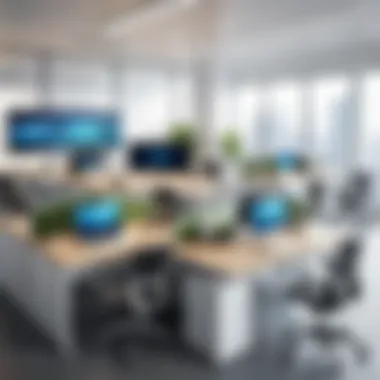
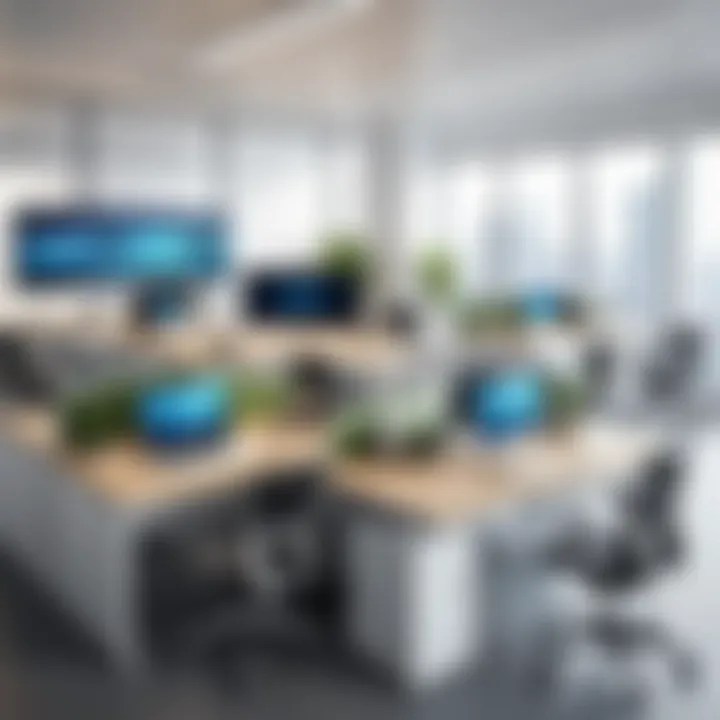
On the flip side, distractions can loom large in these lounge areas. The relaxed atmosphere is sometimes a double-edged sword. While a cozy setup invites creativity, it can also foster distractions. Soft music, conversations around, or even the allure of a nap can interrupt the focus needed for deep work. The key characteristic here is the fine line between a relaxed mood and complete disengagement.
Finding focus amidst distractions is critical for software developers and IT professionals who often must navigate complex problems. The unique challenge of this environment is figuring out how to synthesize relaxation while also keeping the mind sharp. As tempting as it is to lounge, avoiding the pitfalls of a casual setting requires discipline and self-awareness in using these lounge spaces effectively.
"A relaxed mind is a productive mind, but a distracted mind might mean losing that productivity game."
Multi-Function Tables and Their Uses
In today’s fast-paced, ever-evolving work environment, multi-function tables have emerged as a pivotal solution for both home and office settings. Recognized for their versatility, these tables serve multiple purposes, blending functionality with flexibility to meet diverse needs. The significance of these tables cannot be overstated; they adapt to the demands of different activities, allowing users to transition smoothly from one task to another without the need for additional furniture. This adaptability is not just a convenience; it can substantially enhance productivity by creating a dynamic workspace tailored to individual preferences.
Variety of Functions Achievable
Multi-function tables are designed to accommodate a broad spectrum of activities. Whether you need a dedicated surface for your laptop, a place to enjoy meals, or a space for creative projects, these tables are up for the challenge. Here are some common functions they fulfill:
- Workspace: Equipped with enough surface area, they can serve as desks for intensive work. Attachments like monitor stands or keyboard trays can be incorporated, enhancing ergonomics.
- Dining Area: Some tables easily convert into dining surfaces, making them ideal for those who live in smaller spaces requiring multi-use furniture.
- Creative Space: With additional features like foldable or extendable designs, these tables lend themselves well to hobbies like crafting or drawing, providing ample space when needed.
“The right multi-function table can turn an ordinary corner of your home into a vibrant workspace or gathering area.”
Integrating these multifunctional designs into your workspace or home can maximize utility and minimize clutter. The key to their appeal lies in their ability to transform settings seamlessly, ensuring that users aren’t confined to rigid layouts.
Factors to Consider When Choosing
When it comes to selecting a multi-function table, a couple of key elements should influence your decision-making process.
Functionality vs. Aesthetic
Balancing functionality against aesthetic appeal is crucial in making a choice that suits both your practical needs and your personal style. A table that performs multiple roles effectively while also enhancing the visual charm of your space can be a game changer. Here, the aesthetic doesn’t just refer to looks but also how well the piece integrates into the existing decor.
- Key Characteristic: A table should be attractive and practical at once. Pieces that feature clean lines and muted colors may blend well in diverse environments without being overwhelming.
- Unique Feature: The ability to easily shift from one purpose to another should not compromise its design. A well-crafted multi-function table will have features that function beautifully, such as hidden storage compartments or adjustable heights, all while maintaining an elegant presence.
This balance can lead to a cohesive environment that doesn’t feel sporadic or haphazard, which is especially beneficial for clear-headed focus and creativity.
Space Considerations
Space considerations play a crucial role in the effectiveness of a multi-function table. The environment in which you plan to place the table will significantly influence your selection process.
- Key Characteristic: Understanding the dimensions of your room can help identify the right size for a table that can perform various functions without overwhelming the area.
- Unique Feature: Many models come with the ability to fold or retract, which is particularly advantageous for smaller spaces. This versatility can maximize usable area while providing all necessary functionalities, making it a practical choice in bustling settings.
When choosing a table, take measurements to ensure that you’re choosing something that fits well in both style and space.
Comparison of Desk Alternatives
In today's fast-paced work environment, finding the most suitable workspace solution has become paramount. With the surge of adaptable furniture, understanding the nuances of various desk alternatives has never been more relevant. Each alternative offers distinct features tailored to different needs, meaning that a careful comparison can lead to enhanced productivity and overall comfort. This section aims to provide an insightful comparison of multiple desk alternatives, underlining the importance of personal needs, work styles, and the crucial balance of function with aesthetics.
Evaluating Options Based on User Needs
Personal Preferences
One significant aspect shaping the choice of desk alternatives is personal preferences. Individual comfort dictates many decisions; whether someone prefers to sit or stand, lean, or recline can heavily influence their productivity. For instance, many folks love the feel of standing desks, claiming they help with energy and focus, while others find comfort only when seated. This preference leads to improved mental engagement—a must in the current work climate.
The unique characteristic of personal preferences is that they can greatly shift based on daily moods or specific tasks. For example, a software developer might feel more energized typing away at a standing desk when tackling creative problems, only to find that debugging requires the focused concentration that sitting provides.
Understanding these preferences and adapting workspaces accordingly is seen as a beneficial move. It not only boosts satisfaction but also aligns with trends advocating for ergonomic designs. After all, what’s the point of a workspace if it doesn’t cater to your own unique needs?
Type of Work
The type of work being done shapes the choice of desk alternatives decidedly. Not all jobs require the same level of physical engagement. Those in IT-related fields, for instance, often engage deeply with computer screens for prolonged periods. Such tasks may be better suited for a traditional desk setup to minimize posture-related issues. Conversely, roles heavy on collaboration might benefit from convertible desk solutions that encourage interaction and flexibility in arrangement.
The primary characteristic here is adaptability. A graphic designer may thrive on a surface that easily transforms between seated and standing levels, while a data analyst often needs a stationary yet spacious work area to manage multiple screen setups. This trait highlights why understanding one’s work type isn’t just about comfort; it’s essential for aligning physical space with job demands. Without this alignment, the effectiveness of various desk alternatives diminishes, leading to discomfort and lowered productivity.
Cost-Benefit Analysis of Desk Alternatives
When it comes to desk alternatives, financial considerations play a crucial role. The burgeoning market for ergonomic and multifunctional desks can mean a significant investment, prompting potential users to weigh their options carefully. Does the enhanced productivity truly offset the price you might pay?
Conducting a cost-benefit analysis is critical. For example, standing desks generally have a higher upfront cost compared to traditional ones but can lead to various long-term health benefits, possibly reducing medical expenses tied to poor posture. On the flip side, inexpensive coffee tables or compact wall-mounted desks may offer short-term satisfaction but might lack lasting durability or functionality.
It’s about finding that sweet spot where the price you pay aligns with the value you receive.
Here's a concise list of factors to consider in your analysis:
- Durability: How long will the desk last?
- Adjustability: Can the desk accommodate your changing work styles?
- Comfort: What impact does the desk have on your overall well-being?
- Functionality: Is it versatile enough for different tasks?
The End: Crafting Your Ideal Workspace
Creating the ideal workspace is more than just slapping together a desk, chair, and a monitor. It involves thoughtful consideration of how various options can elevate comfort and productivity. This article highlights the burgeoning need for adaptable work environments and emphasizes that the choice of workspace can significantly impact one’s daily experience at work.
In a world where flexibility reigns supreme, the available alternatives to traditional desks cater to a range of preferences and physiological needs. While standing desks provide an active option for those wishing to alleviate back pain, convertible desks give flexibility to switch between various activities seamlessly. Kneeling desks might encourage better alignment and posture, but they are not for everyone; it all boils down to personal preference. Ultimately, crafting a workspace that suits one's specific requirements can lead to enhanced focus and productivity.
The design of your workspace can affect not just your efficiency but also your mental health. A comfortable environment fosters creativity and innovation, as comfort allows the mind to wander and explore new ideas. Conversely, an uncomfortable setup can lead to distractions and disengagement.
Key Takeaways from Desk Alternatives
Here are some condensed insights distilled from the exploration of desk alternatives:
- Health-centric designs: Many alternatives focus on relieving strain and improving posture. For example, standing desks can help combat prolonged sitting, while kneeling desks encourage proper spinal alignment.
- Space optimization: Options like wall-mounted desks and coffee table workspaces are valuable for small living areas, enabling efficient use of limited real estate without sacrificing function.
- Personalization and adaptability: Nearly all desk alternatives offer various styles and configurations to match personal tastes and workplace needs. It’s vital to consider not just the physical setup but also how it fits into your overall workflow.
- Multi-functionality: Furniture that serves several purposes can save both space and money, eliminating the need for multiple pieces of equipment.
"The workspace must fit the worker, not the other way around."
Encouragement to Explore and Innovate
Exploring desk alternatives can feel overwhelming at first, but it presents an opportunity to innovate your workspace. Don’t be afraid to experiment with layouts and furniture until you find what works best for you. The journey is as valuable as the destination.
Consider integrating tech innovations into your setup. Smart desks that remember your preferred height settings or adjustable furniture with built-in cables can enhance user experience.
Additionally, engage with communities on platforms like reddit.com or facebook.com to gather insights and ideas from others who have transformed their workspaces. Sharing experiences can provide fresh perspectives and spark creativity in how you might rethink your own setup.
Lastly, the road to crafting your ideal workspace is deeply personal, involving trial and error. Embrace change and challenge conventional norms; after all, the workspace that truly inspires you could lead to groundbreaking ideas and productivity. Make the effort to explore the options available; your body and mind will thank you.







